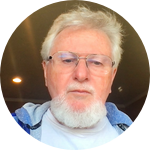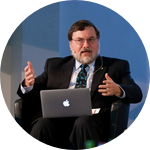About This Project
It has been suggested that diatoms and other ocean biologics are transported to the atmosphere when waves break and there they seed supercooled water droplets to form ice crystals. We suspect otherwise and wish to test this idea. Surface water from off the Australian East coast will be compared with surface water from Antarctica. Biologics will be distinguished from mineral salts and particles and the ice nucleating efficiency of each determined.
Ask the Scientists
Join The DiscussionWhat is the context of this research?
It has recently been shown that incident neutrons can initiate the freezing of a volume of supercooled water, in what we call the snowball paper. This new finding has ramifications for the interpretation of both experimental data on the nucleation of laboratory samples of supercooled water and on the interpretation of ice nucleation involved with cloud physics. If some of the cloud nucleation previously attributed to dust, soot or aerosols has, in fact, been caused by neutrons, this may require fresh consideration in climate models. Since cosmogenic neutrons have a greater flux at high latitudes, estimates of ice nucleates in these regions may be larger than required to accurately model cloud and condensation properties.
What is the significance of this project?
As the climate warms and Arctic sea ice retreats, direct measurements of cloud cover and solar radiation help to evaluate and improve models. Six state-of-the-art models adequately capture near-surface meteorological parameters, but most fail to capture the vertical structure of clouds over the Arctic Ocean. Cloud microphysics schemes should be improved based on the observation that supercooled liquid clouds are maintained even in low-temperature environments below -20°C. It seems likely that neutrons and not dust and soot or biologics are responsible for observed nucleation and reported discrepancies.
What are the goals of the project?
We argue that at high latitudes, neutrons cause nucleation of supercooled water droplets in clouds, and not dust or diatoms which have been blown up into the atmosphere. We will test this hypothesis by measuring the ice nucleation ability/capacity of surface waters collected from both the East Coast of Australia and Antarctica. The nucleation device, known as ALTA can provide statistically significant data on nucleation probability. We will determine, by both dilution series and size filtering, the particle size regimes which cause nucleation at a given supercooling level, such as that found in clouds.
Detailed measurements will allow cloud microphysics models to be adapted and incorporate neutrons as a sources, with latitude dependence.
Budget
We need to get far offshore Coff's Harbour to collect seawater form the ocean surface.
We need to ask a scientist travelling to Antarctica to collect and return some surface water. It must then travel from Hobart to Sydney.
We then need to test both sets for ice nucleation properties, with both a dilution series and a biology/mineral sort as well as a size sort, to be sure what is causing the nucleation.
No other monies are sought.
Endorsed by
 Project Timeline
Project Timeline
By March, 2022 we will have gathered sea water from both off the east Coast of Australian and from the Antarctic. We will spend five weeks doing a dilution series and measuring the nucleation temperature for each volume/dilution. It will then take two weeks to write up the results.
Oct 18, 2021
Project Launched
Mar 31, 2022
gather sea water samples from both off Coffs harbour and from Antarctica 9 a litre in each case is sufficient)
May 14, 2022
complete experiments on dilution, nucleation, temperature profiles for each sample
May 31, 2022
write up results as science paper for publication in PCCP or JCP
Meet the Team
Affiliates
Team Bio
Wilson and Haymet have studied ice nucleation for many years and in many ways lead the way in determining if an additive helps or hinders the supercooling ability of a given solution. Haymet is a Board member of the Antarctic Science Foundation and will source surface water form Antarctica. Wilson has access to surface water from off the coast of Australia. Wilson's lab has students capable of measuring the nucleation statistics f these waters, with a filtering and dilution series on play
Peter Wilson
Peter has recently started as Leader of Science Education at the Kings School in Parramatta.Professor Peter Wilson was also Director of Special Projects at Southern Cross University from March 2019, after having been Associate Dean Global at the University of Tasmania for the previous five years. Prior to that he was Director of the G30 Program and Professor of Life and Environmental Sciences at the University of Tsukuba in Japan.Professor Wilson graduated in Physics from the University of Otago, NZ, in 1981, gained an MSc in Electronics, also from Otago, in 1984 and completed his PhD at Otago in 1989. After several postdoctoral fellowships at Otago and at Victoria University Wellington, Peter joined Cornell university, researching cryobiology and lipid bilayer phase transitions using x-ray diffraction.Peter’s research career has taken him to California as a Research Fellow at Scripps Institution of Oceanography, where he has been on the staff as Adjunct since 2007. He has also worked at the University of Copenhagen and Houston University, predominantly researching ice nucleation. Notable achievements in physics have been the most accurate measurement to date of the thickness of the ice-water interface and the first measurement of the voltage caused by ion exclusion as single ice crystals grow into salt solutions. Peter’s research has also included development of a new technique to measure the statistics of heterogeneous ice nucleation and so determine if additives are effective, such as low dose kinetic inhibitors in oil pipelines. He has worked extensively with Chevron Texaco and has enjoyed wide ranging collaborations with a number of leading research groups, such as measuring the ice-phobicity of slippery liquid infused porous substances, created at Harvard University.
Anthony Haymet
Tony Haymet is a University and Institution leader, entrepreneur, business founder & owner, change manager, scientist, academic and experienced board member. Until June 30, 2020, Haymet was Director, Oceans, for the Minderoo Foundation based in Perth, Western Australia, where he established leadership and management for a $49 million philanthropic research program. Haymet is Vice-Chair of the Board of Trustees of Worldfish, and co-founder and co-owner of MRV Systems LLC, a for-profit company manufacturing in-ocean robots, both sea- and air-launchable, with a wide variety of sensors.
Haymet was the tenth Director of Scripps Institution of Oceanography, and also UCSD Vice-Chancellor for Marine Sciences, and is now Emeritus Director & Vice-Chancellor and Distinguished Professor Emeritus. Scripps is a 117-year-old, “soft money” US$200 million earth science institution of 1600+ people addressing societally relevant issues in the fields of fisheries, the solid earth, seismology, oceans & atmosphere, and marine biology. Haymet led 300 projects in 60 EEZs. Haymet was previously Chief of CSIRO Marine Research, then Marine & Atmospheric Research, founder of the cross-cutting “Wealth from Oceans” Flagship, and Established Chair of Theoretical Chemistry at the University of Sydney. As part of the “one CSIRO” change process, Haymet merged two divisions of CSIRO and led change processes, especially in external and internal communications across 52 sites.
Haymet is an elected Fellow of the Australian Academy of Engineering (ATSE) and the Australian Chemical Institute (RACI). He is the author of 175 peer-reviewed publications, many highly cited (Google scholar h-index 59). He has advised governments of many jurisdictions, including Australia, USA, California (5th largest economy in the world) and Tasmania.
Lab Notes
Nothing posted yet.
Project Backers
- 6Backers
- 100%Funded
- $5,701Total Donations
- $950.17Average Donation



